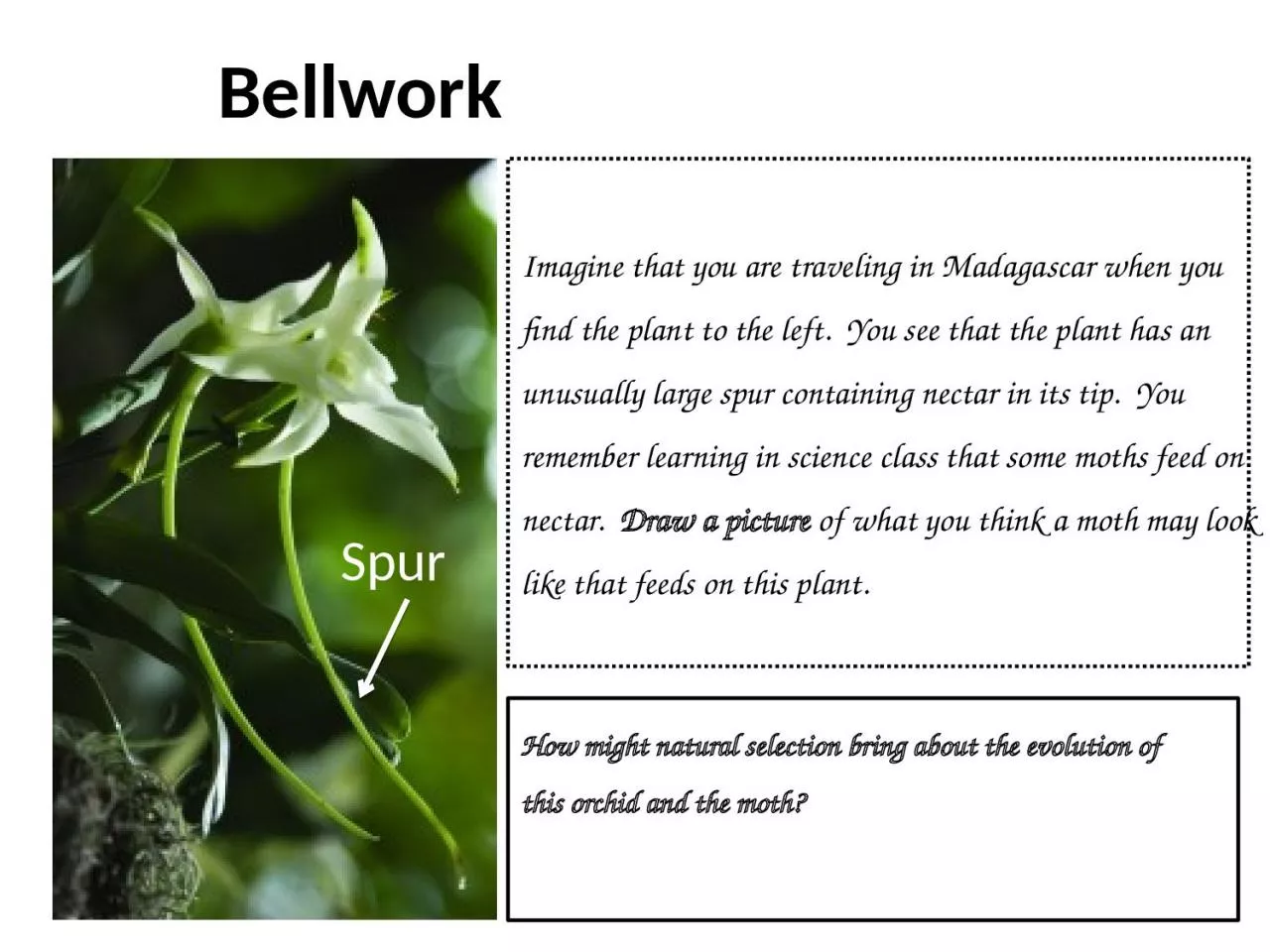

the left You see that the plant has an unusually large spur containing nectar in its tip You remember learning in science class that some moths feed on nectar Draw a picture of what you think a moth may look like that feeds on this plant ID: 1022300
Download Presentation The PPT/PDF document "Bellwork Spur Imagine that you are trave..." is the property of its rightful owner. Permission is granted to download and print the materials on this web site for personal, non-commercial use only, and to display it on your personal computer provided you do not modify the materials and that you retain all copyright notices contained in the materials. By downloading content from our website, you accept the terms of this agreement.
1. BellworkSpurImagine that you are traveling in Madagascar when you find the plant to the left. You see that the plant has an unusually large spur containing nectar in its tip. You remember learning in science class that some moths feed on nectar. Draw a picture of what you think a moth may look like that feeds on this plant.How might natural selection bring about the evolution of this orchid and the moth?
2. Today’s WHAT: I will evaluate and analyze mechanisms and patterns of evolution.Today’s HOW: I will write notes. I will read and discuss scenarios with a partner.
3. KEY CONCEPT Evolution occurs in patterns.
4. REMEMBER: Evolution through natural selection is not random. Natural selection can have direction.The effects of natural selection add up over time.
5. The 3 patterns we’re going to discuss today are:CoevolutionConvergent EvolutionDivergent EvolutionWe’ll also look at how these might be seen in the fossil record
6. Coevolution
7. Sometimes organisms that are closely connected to one another by ecological interactions evolve together.An evolutionary change in one organism may also be followed by a corresponding change in another organism.The process by which two species evolve in response to changes in each other over time is called coevolution.Co-evolution
8. Species A evolves an adaptation in response to species BSpecies B evolves in response to the adaptation of species ACoevolution
9. Coevolution can occur with species that help or compete with each other
10. The Star Orchid and the Hawk Moth
11. Mimicry occurs when one organism evolves to look like the other in order to benefit itself. The mimic benefits from the situation while the organism it mimics in unaffected.Example: Orchid flowers that mimic female waspsMimicry is another example of coevolution
12. Convergent Evolution
13. Convergent evolution describes evolution toward similar traits in unrelated species.When two species are similar in a particular characteristic, it’s only convergent evolution if their ancestors were not similar Convergent Evolution
14. Divergent Evolution
15. Divergent evolution describes evolution toward different traits in closely related species. Divergent evolution can lead to speciation.kit foxancestorred fox
16. leads toleads toleads to
17.
18. How does this affect the fossil record??
19. Things to Consider:Stasis - The organisms in the fossil record looks the same from when they appear to when they disappear; Sudden appearance - When a species does not arise by gradually changing steadily from its ancestors; it appears all at once and fully formed.Sequential nature – Based on the layers of rock, we sequence organisms in the fossil record. What might cause stasis or sudden appearance?So what about the fossil record…
20. WHICH PATTERN IS IT? coevolution convergent evolution divergent evolution divergent evolutionThe Galápagos finches evolved through natural selection from a common ancestor into a wide variety of different looking species with different kinds of beakshttp://images.encarta.msn.com/xrefmedia/aencmed/targets/illus/ilt/T014608A.gif
21. WHICH PATTERN IS IT? coevolution convergent evolution divergent evolution coevolutionHummingbirds have a beak just the right length to reach the nectar in a cardinal flower and as they feed their foreheads bump into the pollen structure. Cardinal flowers are red which hummingbirds can see, but bees can’t, and their pollen structure is at just the right height for the hummingbird to pick up pollen as it feeds.
22. WHICH PATTERN IS IT? coevolution convergent evolution divergent evolution Convergent evolutionWhales, sharks, and penguins all have streamlined bodies and fins/flipper for moving in water even though they belong in different animal groups (mammals, fish, and birds)
23. WHICH PATTERN IS IT? coevolution convergent evolution divergent evolution divergent evolutionBeaver in North America and capybara in South America are closely related species living in very differentenvironments that have evolved to look differentover time.Beaver NORTH AMERICAMuskratCapybaraSOUTH AMERICACoypuBeaver MuskratBeaver andMuskratCoypu BIOLOGY by Miller and Levine Pearson Publishing
24. WHICH PATTERN IS IT? coevolution convergent evolution divergent evolution divergent evolutionThe tortoises on the Galapagos islands share a common ancestor, but over time they have become adapted for obtaining food in different habitats on different islands by having different neck lengths